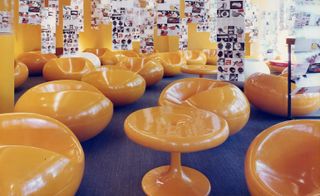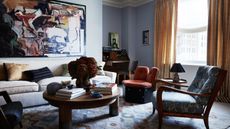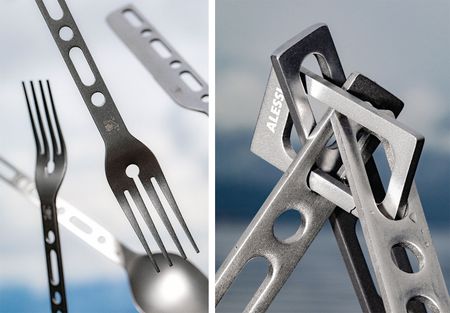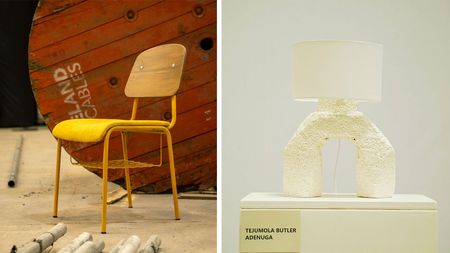Eero Aarnio at 85: ‘I am the master of my own design’

At 85 years old, Finnish design legend Eero Aarnio shows no signs of slowing down. A pioneer of plastic and fibreglass furniture with a penchant for the playful, Aarnio is the creative vision behind some of the world’s most recognisable designs for brands like Magis, Asko and Adelta.
As Finland marks the centenary of its independence this year, Finnish modernism is enjoying a revival. Like his counterparts Ilmari Tapiovaara, Alvar Aalto, and Eero Saarinen, Aarnio is seeing a renewed interest in his work. He was the subject of a major retrospective at the Design Museum Helsinki last summer, which has since travelled to the Vandalorum Museum in Värnamo, Sweden, where it is currently on view until 8 October.
Born in Helsinki in 1932, Aarnio hasn’t strayed far from his roots. Today, he lives and works a short drive from the Finnish capital in Veikkola with his wife of 61 years, Pirkko Attila. The modernist lakeside home – designed by Aarnio himself in 1989 – is a mini-museum in itself, housing a trove of his seminal products, prototypes and personal artefacts. A litter of his ‘Puppy’ stools stand to attention in one leafy corner; a collection of Portugese Roosters of Barcelos is on display in his kitchen. His garden has been transformed into an outdoor gallery of sorts, and Aarnio often enjoys a pilgrimage to the Finnish smoke sauna at the bottom of it.
A sublime vision of organised chaos, his studio is a technological void – Aarnio still draws everything by hand and there’s no computer to be seen. A couple of framed New York Times crosswords hang on the wall opposite – a beaming Aarnio explains he’s been a clue a few times. Tacked next to them, a Post-It note is curiously scrawled with a Japanese version of the designer’s name, Aaroniero Arruruerie (the ever-surprising designer reveals a popular manga character was named after him).

‘Ball Chair’, 1966, produced by Asko
Elsewhere, a hidden sliding door in the living room reveals a collage of vintage magazine covers, starring his most celebrated design: the ‘Ball Chair’. Imagined as a ‘room within a room’ (in fact, Aarnio’s own ‘Ball Chair’ includes a fully functioning red telephone), it was daringly modern for its time. Film buffs might recognise the iconic chair from Dazed and Confused (1993) or Mars Attack! (1996). And its beginnings are just as quixotic as science fiction.
As the story goes, the idea for the ‘Ball Chair’ came to Aarnio when he was just a year old. ‘We were living in an apartment building in Helsinki and my mother put me out on the balcony in a round wicker basket to take a nap,’ he explains. ‘I looked up and saw the round, blue sky framed by the basket. That’s when I decided when I grew up I would design the Ball Chair.’
Fast forward to 1954, when a 22-year-old Aarnio was applying to the School of Applied Arts in Helsinki (where he would design his first product – the ‘Rattan Stool’ – still in production today). One of the tasks he was given for the admission test was to draw a person sitting and reading in a chair. ‘I’ve never been good at drawing living creatures – people especially,’ remarks the designer. Instead, a sly Aarnio sketched a person sitting behind a huge newspaper enclosed in a red circle. ‘That might really be where I got the idea for the Ball Chair,’ he quips impishly. (A testament to his proclivity for storytelling, alternative Aarnio lore has him professing the idea came to him from being inside a boat made out of fibreglass).
It would be another decade before Aarnio returned to the idea of a globe-shaped design, sketching the first version of the ‘Ball Chair’ in 1963. Aarnio was initially reluctant to show it to anyone. ‘I didn’t think furniture companies would understand it, so I decided to make the first prototype myself.’

The making of a ‘Ball Chair’
At the time, Aarnio’s brother-in-law was working in a school Salo, a town 100km northwest from Helsinki. Aarnio made the pilgrimage to the school’s workshop over the course of several weekends, producing the first prototype of the ‘Ball Chair’. A serendipitous visit from a pair of young Asko product managers resulted in the ‘Ball Chair’ being put into production.
The ‘Ball Chair’ was a radical departure in aesthetic and material, its use of fibreglass heralded a new chapter of furniture design. The chair made its debut in 1966 at the International Furniture Fair in Cologne. It was an instant hit, inevitably spawning a wave of knock-offs (thankfully, the newly authorised licensee Eero Aarnio Originals combats these counterfeits). Aarnio’s ‘Pastil’ (1967) and ‘Bubble’ (1968) chairs both stem from the ‘Ball Chair’: in the former, Aarnio was inspired to create a transparent version to allow more light inside, while the latter was intended to resolve the wasted space within the ‘Ball Chair’.
The designer says, ‘I think that the chair plays a major role in furniture design and it is the most difficult and challenging piece of furniture to design.’ To wit, his oeuvre includes the bulbous ‘Tomato’ and ‘Pastil’ chairs, as well as the ‘Focus’, ‘Rocket’, ‘Cognac XO’ and ‘Rosinante’ chairs.
But he does have a favourite. ‘The most interesting piece for me is the Bubble Chair which is made like a soap bubble, air is blown to a heated acrylic sheet,’ explains Aarnio. ‘Therefore there is no need for a mould and the form always comes out the same, following the laws of nature (like a soap bubble).’

‘Mushroom’ chairs, 1961
Lighting also forms a large part of his catalogue, from the memorable ‘Ghost’ lamp to the ‘Pinja’, ‘Swan’, and ‘Flamingo’ lights, as does children’s furniture – the ‘Puppy’ stool/sculpture and ‘Pingy’ are among his most popular designs. His products appeal to a wide range of audiences. ‘I think there can be good design in all price ranges; money is not a prerequisite for good taste,’ he says.
In spite of his infectiously warm and open nature, Aarnio has always worked alone. ‘I am the master of my design,’ he says, furrowed brows momentarily betraying an uncharacteristic seriousness. Aarnio, at any rate, seems to be having just as much fun by himself, though he counts his wife and daughters among his co-conspirators. He’s always been one to break traditional design moulds: ‘A designer must always be an artist but and an artist does not have to be a designer.’
Today, his works are represented in museums across the globe, from MoMA in New York to the Bauhaus Museum in Sydney and Vitra Design Museum in Weil am Rhein. His cheerful designs have garnered him a plethora of awards (among them, a Wallpaper* Design Award in 2011, for his ‘Kubo Brightlight’ therapy lamp).
The design world has changed dramatically over the past six decades, ebbing and flowing between trends, shapes, styles, and materials. Still, Aarnio’s fantastical furniture endures. ‘If an object is functional, well made and beautiful, it will retain its value through many generations and can be considered sustainable. It doesn’t matter if the product is traditional or modern,’ muses Aarnio. The perpetually positive thinker finally offers: ‘Keep dreaming, and carry out your dreams.’

Left, a hidden sliding door in Aarnio’s home reveals vintage magazine covers starring his most famous design. Right, the original ‘Ball Chair’, 1966, manufactured by Asko, complete with a functioning landline telephone

Left, ‘Screw Table’, 1991. Right, as part of his admission test to the School of Applied Arts in Helsinki , Aarnio sketched a person sitting behind a huge newspaper enclosed in a red circle

Left, Aarnio’s home is a mini-museum of his seminal products. Right, a ’Bubble’ chair, 1968, at the entrance.

Aarnio’s daughters relax in his space-age ‘Bubble’ chairs

The Ring’ chair (left), 2009, takes its cues from the ‘Bubble’ chair (right)

Left, a colourful assortment of the designer’s ‘Puppy’ stools, 2005, for Magis. Right, ‘Tomato’ chair, 1971, in the sylvan surrounds of Aarnio’s modernist home.

Left, Aarnio at work in his home-studio. Right, the living room, with a ‘Ghost’ lamp, 2011; ‘Mini Pony’, 2011; and his first-ever design, the ‘Rattan Stool’, 1954, in view.

Left, a New York Times crossword puzzle in which Aarnio has been a clue. Right, a popular Japanese manga character, Aaroniero Arruruerie, was also named after the designer.

‘Focus’ chairs, 2002, for Adelta, and ‘Parabel’ table, 1994

‘Pastil’ chairs, 1967

‘Swan’ lamps, 2007

‘Double Bubble’ lamps 2001

A young Aarnio at work
Wallpaper* Newsletter
Receive our daily digest of inspiration, escapism and design stories from around the world direct to your inbox.
-
 Step inside this Upper East Side jewel box apartment
Step inside this Upper East Side jewel box apartmentThis radiant Lexington Avenue home is a harbinger of good things for the Upper East Side, and the latest focus of The Inside Story, our series spotlighting intriguing and innovative interior design
By Anna Solomon Published
-
 A new hilltop California home is rooted in the landscape and celebrates views of nature
A new hilltop California home is rooted in the landscape and celebrates views of natureWOJR's California home House of Horns is a meticulously planned modern villa that seeps into its surrounding landscape through a series of sculptural courtyards
By Jonathan Bell Published
-
 Is a tiny tattoo the best holiday souvenir? Kimpton Hotels think so
Is a tiny tattoo the best holiday souvenir? Kimpton Hotels think soIn partnership with Tiny Zaps, Kimpton Hotels is bringing city-inspired tattoo pop-ups to five U.S. locations
By Sofia de la Cruz Published
-
 Postcard from Helsinki Design Week 2024
Postcard from Helsinki Design Week 2024The Finns lead the way when it comes to integrating design into everyday life, as they deftly demonstrate during Helsinki Design Week 2024
By Hugo Macdonald Published
-
 Alessi Occasional Objects: Virgil Abloh’s take on cutlery
Alessi Occasional Objects: Virgil Abloh’s take on cutleryBest Cross Pollination: Alessi's cutlery by the late designer Virgil Abloh, in collaboration with his London studio Alaska Alaska, is awarded at the Wallpaper* Design Awards 2023
By Rosa Bertoli Published
-
 Design Miami 2022: highlights from the fair and around town
Design Miami 2022: highlights from the fair and around townDesign Miami 2022 (30 November – 4 December) aims at ‘rebooting the roots of our relationship with nature and collective structures, ecospheres, and urban contexts’
By Sujata Burman Last updated
-
 Salon Art + Design 2022: design highlights not to miss
Salon Art + Design 2022: design highlights not to missWallpaper* highlights from Salon Art + Design 2022, New York
By Tilly Macalister-Smith Last updated
-
 Design Week Lagos 2022 celebrates creativity and innovation in West Africa and beyond
Design Week Lagos 2022 celebrates creativity and innovation in West Africa and beyondCurated by founder Titi Ogufere, Design Week Lagos 2022 is based on a theme of ‘Beyond The Box’
By Ugonna-Ora Owoh Last updated
-
 Designart Tokyo transforms the city into a museum of creativity
Designart Tokyo transforms the city into a museum of creativityDesignart Tokyo presents global design highlights through a series of exhibitions involving global creative talent and traditional Japanese craft
By Danielle Demetriou Last updated
-
 Helsinki Design Museum celebrates Finnish icons Vuokko and Antti Nurmesniemi
Helsinki Design Museum celebrates Finnish icons Vuokko and Antti NurmesniemiA new exhibition in Helsinki (28 October 2022 – 9 April 2023) highlights the bold and bright creations of Finnish textile artist Vuokko Nurmesniemi and her equally talented husband Antti, Wallpaper* visits the designers’ house in Kulosaari
By Emma O'Kelly Last updated
-
 Tom Dixon marks his studio's 20 years with a show of design experiments
Tom Dixon marks his studio's 20 years with a show of design experimentsMushroom, cork, steel coral and more: Tom Dixon showcases an overview of his design experiments as he celebrates his practice's 20 years
By Rosa Bertoli Last updated